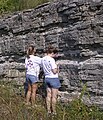Limestone
| Sedimentary rock | |
 Limestone outcrop in the Torcal de Antequera nature reserve of Málaga, Spain | |
| Composition | |
|---|---|
| Calcium carbonate: inorganic crystalline calcite or organic calcareous material |
Limestone is a carbonate sedimentary rock that is often composed of the skeletal fragments of marine organisms such as coral, foraminifera, and molluscs. Its major materials are the minerals calcite and aragonite, which are different crystal forms of calcium carbonate (CaCO3). A closely related rock is dolomite, which contains a high percentage of the mineral dolomite, CaMg(CO3)2. In old USGS publications, dolomite was referred to as magnesian limestone, a term now reserved for magnesium-deficient dolomites or magnesium-rich limestones.

About 10% of sedimentary rocks are limestones. The solubility of limestone in water and weak acid solutions leads to karst landscapes, in which water erodes the limestone over thousands to millions of years. Most cave systems are through limestone bedrock.
Limestone has numerous uses: as a building material, an essential component of concrete (Portland cement), as aggregate for the base of roads, as white pigment or filler in products such as toothpaste or paints, as a chemical feedstock for the production of lime, as a soil conditioner, and as a popular decorative addition to rock gardens.
Description




Like most other sedimentary rocks, most limestone is composed of grains. Most grains in limestone are skeletal fragments of marine organisms such as coral or foraminifera. These organisms secrete shells made of aragonite or calcite, and leave these shells behind when they die. Other carbonate grains composing limestones are ooids, peloids, intraclasts, and extraclasts.
Limestone often contains variable amounts of silica in the form of chert (chalcedony, flint, jasper, etc.) or siliceous skeletal fragment (sponge spicules, diatoms, radiolarians), and travertine (a precipitate of calcite and aragonite). Secondary calcite may be deposited by supersaturated meteoric waters (groundwater that precipitates the material in caves). This produces speleothems, such as stalagmites and stalactites. Another form taken by calcite is oolitic limestone, which can be recognized by its granular (oolite) appearance.
The primary source of the calcite in limestone is most commonly marine organisms. Some of these organisms can construct mounds of rock known as reefs, building upon past generations. Below about 3,000 meters, water pressure and temperature conditions cause the dissolution of calcite to increase nonlinearly, so limestone typically does not form in deeper waters (see lysocline). Limestones may also form in lacustrine[1] and evaporite depositional environments.[2][3]
Calcite can be dissolved or precipitated by groundwater, depending on several factors, including the water temperature, pH, and dissolved ion concentrations. Calcite exhibits an unusual characteristic called retrograde solubility, in which it becomes less soluble in water as the temperature increases.
Impurities (such as clay, sand, organic remains, iron oxide, and other materials) will cause limestones to exhibit different colors, especially with weathered surfaces.
Limestone may be crystalline, clastic, granular, or massive, depending on the method of formation. Crystals of calcite, quartz, dolomite or barite may line small cavities in the rock. When conditions are right for precipitation, calcite forms mineral coatings that cement the existing rock grains together, or it can fill fractures.
Travertine is a banded, compact variety of limestone formed along streams, particularly where there are waterfalls and around hot or cold springs. Calcium carbonate is deposited where evaporation of the water leaves a solution supersaturated with the chemical constituents of calcite. Tufa, a porous or cellular variety of travertine, is found near waterfalls. Coquina is a poorly consolidated limestone composed of pieces of coral or shells.
During regional metamorphism that occurs during the mountain building process (orogeny), limestone recrystallizes into marble.
Limestone is a parent material of the Mollisol soil group.
Classification
Two major classification schemes, the Folk and the Dunham, are used for identifying the types of carbonate rocks collectively known as limestone.
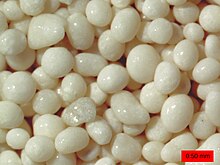
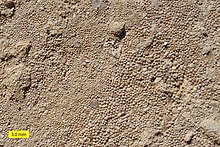
Folk classification
Robert L. Folk developed a classification system that places primary emphasis on the detailed composition of grains and interstitial material in carbonate rocks.[4] Based on composition, there are three main components: allochems (grains), matrix (mostly micrite), and cement (sparite). The Folk system uses two-part names; the first refers to the grains and the second is the root. It is helpful to have a petrographic microscope when using the Folk scheme, because it is easier to determine the components present in each sample.[5]
Dunham classification
The Dunham scheme focuses on depositional textures. Each name is based upon the texture of the grains that make up the limestone. Robert J. Dunham published his system for limestone in 1962; it focuses on the depositional fabric of carbonate rocks. Dunham divides the rocks into four main groups based on relative proportions of coarser clastic particles. Dunham names are essentially for rock families. His work considers whether or not the grains were originally in mutual contact, and therefore self-supporting, or whether the rock is characterized by the presence of frame builders and algal mats. Unlike the Folk scheme, Dunham deals with the original porosity of the rock. The Dunham scheme is more useful for hand samples because it is based on texture, not the grains in the sample.[6]
A revised classification was proposed by Wright (1992).[7] It adds some diagenetic patterns and can be summarized as follows:
This article needs attention from an expert on the subject. The specific problem is: The tables in the Dunham classification article are partly incoherent and need attention; and this table has been copied from that article.. (September 2019) |
| Depositional | Biological | Diagenetic | ||||||||
|---|---|---|---|---|---|---|---|---|---|---|
| Matrix-supported (clay and silt grade) |
Grain-supported | In situ organisms | Non-obliterative | Obliterative | ||||||
| < 10% grains | > 10% grains | With matrix | No matrix | Encrusting binding organisms |
Organisms acted to baffle [clarification needed] |
Rigid organisms dominant |
Main component is cement |
Many grain contacts are microstylolites |
Most grain contacts are microstylolites |
Crystals > 10 μm |
| Carbonate mudstone |
Wackestone | Packstone | Grainstone | Boundstone | Bafflestone | Framestone | Cementstone | Condensed grainstone | Fitted grainstone | Sparstone |
| Components > 2 mm | Crystals < 10 μm | |||||||||
| Floatstone | Rudstone | Microsparstone | ||||||||
Formation
See: Carbonate platform
Limestone landscape



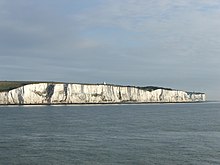
About 10% of all sedimentary rocks are limestones.[8][9]
Limestone is partially soluble, especially in acid, and therefore forms many erosional landforms. These include limestone pavements, pot holes, cenotes, caves and gorges. Such erosion landscapes are known as karsts. Limestone is less resistant than most igneous rocks, but more resistant than most other sedimentary rocks. It is therefore usually associated with hills and downland, and occurs in regions with other sedimentary rocks, typically clays.
Karst topography and caves develop in limestone rocks due to their solubility in dilute acidic groundwater. The solubility of limestone in water and weak acid solutions leads to karst landscapes. Regions overlying limestone bedrock tend to have fewer visible above-ground sources (ponds and streams), as surface water easily drains downward through joints in the limestone. While draining, water and organic acid from the soil slowly (over thousands or millions of years) enlarges these cracks, dissolving the calcium carbonate and carrying it away in solution. Most cave systems are through limestone bedrock. Cooling groundwater or mixing of different groundwaters will also create conditions suitable for cave formation.
Coastal limestones are often eroded by organisms which bore into the rock by various means. This process is known as bioerosion. It is most common in the tropics, and it is known throughout the fossil record (see Taylor and Wilson, 2003).
Bands of limestone emerge from the Earth's surface in often spectacular rocky outcrops and islands. Examples include the Rock of Gibraltar, the Burren in County Clare, Ireland; the Verdon Gorge in France; Malham Cove in North Yorkshire and the Isle of Wight,[10] England; the Great Orme in Wales; on Fårö near the Swedish island of Gotland, the Niagara Escarpment in Canada/United States, Notch Peak in Utah, the Ha Long Bay National Park in Vietnam and the hills around the Lijiang River and Guilin city in China.
The Florida Keys, islands off the south coast of Florida, are composed mainly of oolitic limestone (the Lower Keys) and the carbonate skeletons of coral reefs (the Upper Keys), which thrived in the area during interglacial periods when sea level was higher than at present.
Unique habitats are found on alvars, extremely level expanses of limestone with thin soil mantles. The largest such expanse in Europe is the Stora Alvaret on the island of Öland, Sweden. Another area with large quantities of limestone is the island of Gotland, Sweden. Huge quarries in northwestern Europe, such as those of Mount Saint Peter (Belgium/Netherlands), extend for more than a hundred kilometers.
The world's largest limestone quarry is at Michigan Limestone and Chemical Company in Rogers City, Michigan.[11]
Uses

Limestone is very common in architecture, especially in Europe and North America. Many landmarks across the world, including the Great Pyramid and its associated complex in Giza, Egypt, were made of limestone. So many buildings in Kingston, Ontario, Canada were, and continue to be, constructed from it that it is nicknamed the 'Limestone City'.[13] On the island of Malta, a variety of limestone called Globigerina limestone was, for a long time, the only building material available, and is still very frequently used on all types of buildings and sculptures. Limestone is readily available and relatively easy to cut into blocks or more elaborate carving.[12] Ancient American sculptors valued limestone because it was easy to work and good for fine detail. Going back to the Late Preclassic period (by 200–100 BCE), the Maya civilization (Ancient Mexico) created refined sculpture using limestone because of these excellent carving properties. The Maya would decorate the ceilings of their sacred buildings (known as lintels) and cover the walls with carved limestone panels. Carved on these sculptures were political and social stories, and this helped communicate messages of the king to his people.[14] Limestone is long-lasting and stands up well to exposure, which explains why many limestone ruins survive. However, it is very heavy, making it impractical for tall buildings, and relatively expensive as a building material.
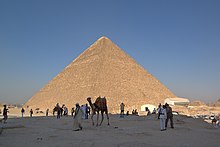

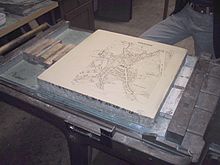
Limestone was most popular in the late 19th and early 20th centuries. Train stations, banks and other structures from that era were normally made of limestone. It is used as a facade on some skyscrapers, but only in thin plates for covering, rather than solid blocks. In the United States, Indiana, most notably the Bloomington area, has long been a source of high-quality quarried limestone, called Indiana limestone. Many famous buildings in London are built from Portland limestone. Houses built in Odessa in Ukraine in the 19th century were mostly constructed from limestone and the extensive remains of the mines now form the Odessa Catacombs.[15]
Limestone was also a very popular building block in the Middle Ages in the areas where it occurred, since it is hard, durable, and commonly occurs in easily accessible surface exposures. Many medieval churches and castles in Europe are made of limestone. Beer stone was a popular kind of limestone for medieval buildings in southern England.
Limestone and (to a lesser extent) marble are reactive to acid solutions, making acid rain a significant problem to the preservation of artifacts made from this stone. Many limestone statues and building surfaces have suffered severe damage due to acid rain. Likewise limestone gravel has been used to protect lakes vulnerable to acid rain, acting as a pH buffering agent. Acid-based cleaning chemicals can also etch limestone, which should only be cleaned with a neutral or mild alkali-based cleaner.
Other uses include:
- It is the raw material for the manufacture of quicklime (calcium oxide), slaked lime (calcium hydroxide), cement and mortar.
- Pulverized limestone is used as a soil conditioner to neutralize acidic soils (agricultural lime).
- Is crushed for use as aggregate—the solid base for many roads as well as in asphalt concrete.
- Geological formations of limestone are among the best petroleum reservoirs;
- As a reagent in flue-gas desulfurization, it reacts with sulfur dioxide for air pollution control.
- Glass making, in some circumstances, uses limestone.[16]
- It is added to toothpaste, paper, plastics, paint, tiles, and other materials as both white pigment and a cheap filler.
- It can suppress methane explosions in underground coal mines.
- Purified, it is added to bread and cereals as a source of calcium.
- Calcium levels in livestock feed are supplemented with it, such as for poultry (when ground up).[17]
- It can be used for remineralizing and increasing the alkalinity of purified water to prevent pipe corrosion and to restore essential nutrient levels.[18]
- Used in blast furnaces, limestone binds with silica and other impurities to remove them from the iron.
- It is used in sculptures because of its suitability for carving.
Occupational safety and health
People can be exposed to limestone in the workplace by inhalation of and eye contact with the dust.
United States
The Occupational Safety and Health Administration (OSHA) has set the legal limit (permissible exposure limit) for limestone exposure in the workplace as 15 mg/m3 total exposure and 5 mg/m3 respiratory exposure over an 8-hour workday. The National Institute for Occupational Safety and Health (NIOSH) has set a recommended exposure limit (REL) of 10 mg/m3 total exposure and 5 mg/m3 respiratory exposure over an 8-hour workday.[19]
Graffiti
Removing graffiti from weathered limestone is difficult because it is a porous and permeable material. The surface is fragile so usual abrasion methods run the risk of "severe surface loss". Because it is an acid-sensitive stone some cleaning agents cannot be used due to adverse effects.[20]
Degradation by organisms
The cyanobacterium Hyella balani can bore through limestone; as can the green alga Eugamantia sacculata and the fungus Ostracolaba implexa.[21]
Gallery
-
A stratigraphic section of Ordovician limestone exposed in central Tennessee, U.S. The less-resistant and thinner beds are composed of shale. The vertical lines are drill holes for explosives used during road construction.
-
Photo and etched section of a sample of fossiliferous limestone from the Kope Formation (Upper Ordovician) near Cincinnati, Ohio, U.S.
-
Biosparite limestone of the Brassfield Formation (Lower Silurian) near Fairborn, Ohio, U.S., showing grains mainly composed of crinoid fragments.
-
Calcined fossils of limestone Northern Black Sea region.
See also
- Chalk – Soft carbonate rock
- Coral sand – Carbonate sand formed in warm oceans
- In Praise of Limestone – Poem by W. H. Auden
- Kurkar – Regional name for an aeolian quartz calcrete on the Levantine coast
- Limepit – Old method of calcining limestone
- Sandstone – Type of sedimentary rock
- Chalk stream
References
- ^ Roeser, Patricia; Franz, Sven O.; Litt, Thomas (1 December 2016). "Aragonite and calcite preservation in sediments from Lake Iznik related to bottom lake oxygenation and water column depth". Sedimentology. 63 (7): 2253–2277. doi:10.1111/sed.12306. ISSN 1365-3091.
- ^ Trewin, N. H.; Davidson, R. G. (1999). "Lake-level changes, sedimentation and faunas in a Middle Devonian basin-margin fish bed". Journal of the Geological Society. 156 (3): 535–548. Bibcode:1999JGSoc.156..535T. doi:10.1144/gsjgs.156.3.0535.
- ^ "Term 'evaporite'". Oilfield Glossary. Archived from the original on 31 January 2012. Retrieved 25 November 2011.
- ^ Carbonate Classification: SEPM STRATA
- ^ Folk, R. L. (1974). Petrology of Sedimentary Rocks. Austin, Texas: Hemphill Publishing.
- ^ Dunham, R. J. (1962). "Classification of carbonate rocks according to depositional textures". In Ham, W. E. (ed.). Classification of Carbonate Rocks. American Association of Petroleum Geologists Memoirs. Vol. 1. pp. 108–121.
- ^ a b Wright, V.P. (1992). "A revised Classification of Limestones". Sedimentary Geology. 76 (3–4): 177–185. doi:10.1016/0037-0738(92)90082-3.
- ^ "Calcite". mine-engineer.com. Archived from the original on 3 March 2008. Retrieved 13 February 2008.
- ^ Limestone (mineral). Archived from the original on 28 October 2009. Retrieved 13 February 2008.
- ^ "Isle of Wight, Minerals" (PDF). Archived from the original (PDF) on 2 November 2006. Retrieved 8 October 2006.
- ^ "Michigan Markers". Michmarkers.com. Archived from the original on 19 December 2007. Retrieved 25 November 2011.
- ^ a b Cassar, Joann (2010). "The use of limestone in historic context". In Smith, Bernard J. (ed.). Limestone in the Built Environment: Present-day Challenges for the Preservation of the Past. Geographical Society of London. pp. 13–23. ISBN 9781862392946. Archived from the original on 15 February 2017.
- ^ "Welcome to the Limestone City". Archived from the original on 20 February 2008. Retrieved 13 February 2008.
- ^ Schele, Linda; Miller, Mary Ellen. The Blood of Kings: Dynasty and Ritual in Maya Art. Kimbell Art Museum. p. 41.
- ^ "Odessa catacombs". Odessa travel guide. Retrieved 13 June 2020.
- ^ Kogel, Jessica Elzea (2006). Industrial Minerals & Rocks: Commodities, Markets, and Uses. SME. ISBN 9780873352338. Archived from the original on 16 December 2017.
- ^ "A Guide to Giving Your Layer Hens Enough Calcium". Poultry One. Archived from the original on 3 April 2009.
- ^ "Nutrient minerals in drinking-water and the potential health consequences of consumption of demineralized and remineralized and altered mineral content drinking-water: Consensus of the meeting". World Health Organization report. Archived from the original on 24 December 2007.
- ^ "Limestone". NIOSH Pocket Guide to Chemical Hazards. CDC. Archived from the original on 20 November 2015. Retrieved 19 November 2015.
- ^ Weaver, Martin E. (October 1995). "Removing Graffiti from Historic Masonry". National Park Service. Retrieved 5 February 2019.
- ^ Ehrlich, Henry Lutz; Newman, Dianne K. (2009). Geomicrobiology (5th ed.). pp. 181–182. ISBN 9780849379079. Archived from the original on 10 May 2016.
Further reading
- Taylor, P. D.; Wilson, M. A. (2003). "Palaeoecology and evolution of marine hard substrate communities" (PDF). Earth-Science Reviews. 62: 1–103. Bibcode:2003ESRv...62....1T. doi:10.1016/S0012-8252(02)00131-9. Archived from the original (PDF) on 25 March 2009.
- Folk, R. L. (1974). Petrology of Sedimentary Rocks. Austin, Texas: Hemphill Publishing.
- Dunham, R. J. (1962). "Classification of carbonate rocks according to depositional textures". In Ham, W. E. (ed.). Classification of Carbonate Rocks. American Association of Petroleum Geologists Memoirs. Vol. 1. pp. 108–121.
- Boynton, Robert S. (1980). Chemistry and Technology of Lime and Limestone. Wiley. ISBN 0471027715.
External links
 Media related to Limestone at Wikimedia Commons
Media related to Limestone at Wikimedia Commons

